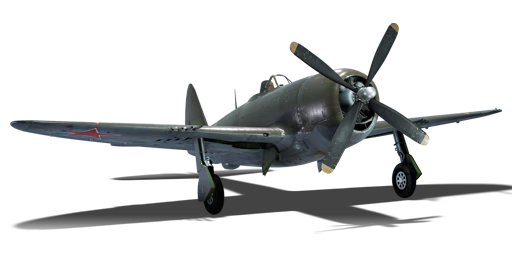



The P-47D-27 (USSR) is a premium Soviet fighter. It was introduced in Update 1.43. This aircraft is a Soviet lend-lease version of the iconic American P-47D-25, with only minor differences including a camouflage colour scheme and Russian forged and welded FAB bombs weighed in kilograms instead of the American bombs AN-M series bombs weighed in pounds.
The fighter does, however, retain the eight deadly 12.7 mm M2 Browning machine guns which this fighter is renowned for, easily ripping off wings and also setting fuel tanks ablaze. The fighter's overall good energy retention makes this an excellent Boom & Zoom fighter but is restricted by its slow initial climbing ability. To counter the slow climb, side climbing at the start is recommended if looking for an altitude advantage to make the most use out of Boom & Zoom. This fighter also doubles as a great ground attacker, mounting an impressive payload (1,250 kg total!), unfortunately, the US did not include HVAR rockets with the lend-lease package, thus they are not available for the Soviet version.
flaps
flaps
flaps
brake
| Belt | Belt filling | Armor penetration (mm) at a distance: | |||||
|---|---|---|---|---|---|---|---|
| 10 m | 100 m | 500 m | 1000 m | 1500 m | 2000 m | ||
| API-T/AP/AP/I | 30 | 27 | 20 | 13 | 9 | 6 | |
| AP-I/AP-I/API-T/I/I | 28 | 26 | 18 | 11 | 7 | 4 | |
| API-T/I/AP/AP/AP-I/AP-I | 30 | 27 | 20 | 13 | 9 | 6 | |
| API-T | 28 | 26 | 18 | 11 | 7 | 4 | |
| AP-I/I/AP-I/I | 28 | 26 | 18 | 11 | 7 | 4 | |
2 × 500 kg FAB-500sv (welded) bomb







 2 x (70 / 165 / 345) %
2 x (70 / 165 / 345) % 
 2 x 148 %
2 x 148 % 

Flight performance | |
|---|---|
Weaponry | |
|---|---|
